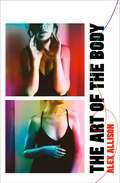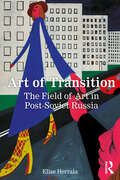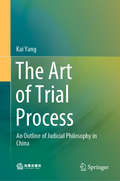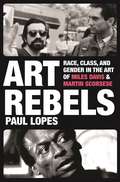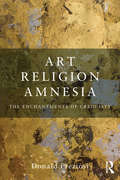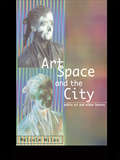- Table View
- List View
The Art of Science: From Perspective Drawing to Quantum Randomness
by Rossella Lupacchini Annarita AngeliniIn addition to linear perspective, complex numbers and probability were notable discoveries of the Renaissance. While the power of perspective, which transformed Renaissance art, was quickly recognized, the scientific establishment treated both complex numbers and probability with much suspicion. It was only in the twentieth century that quantum theory showed how probability might be molded from complex numbers and defined the notion of “complex probability amplitude”. From a theoretical point of view, however, the space opened to painting by linear perspective and that opened to science by complex numbers share significant characteristics. The Art of Science explores this shared field with the purpose of extending Leonardo’s vision of painting to issues of mathematics and encouraging the reader to see science as an art. The intention is to restore a visual dimension to mathematical sciences – an element dulled, if not obscured, by historians, philosophers, and scientists themselves.
The Art of Social Theory
by Richard SwedbergIn the social sciences today, students are taught theory by reading and analyzing the works of Karl Marx, Max Weber, and other foundational figures of the discipline. What they rarely learn, however, is how to actually theorize. The Art of Social Theory is a practical guide to doing just that.In this one-of-a-kind user's manual for social theorists, Richard Swedberg explains how theorizing occurs in what he calls the context of discovery, a process in which the researcher gathers preliminary data and thinks creatively about it using tools such as metaphor, analogy, and typology. He guides readers through each step of the theorist’s art, from observation and naming to concept formation and explanation. To theorize well, you also need a sound knowledge of existing social theory. Swedberg introduces readers to the most important theories and concepts, and discusses how to go about mastering them. If you can think, you can also learn to theorize. This book shows you how.Concise and accessible, The Art of Social Theory features helpful examples throughout, and also provides practical exercises that enable readers to learn through doing.
The Art of Social Theory
by Richard SwedbergIn the social sciences today, students are taught theory by reading and analyzing the works of Karl Marx, Max Weber, and other foundational figures of the discipline. What they rarely learn, however, is how to actually theorize. The Art of Social Theory is a practical guide to doing just that.In this one-of-a-kind user's manual for social theorists, Richard Swedberg explains how theorizing occurs in what he calls the context of discovery, a process in which the researcher gathers preliminary data and thinks creatively about it using tools such as metaphor, analogy, and typology. He guides readers through each step of the theorist’s art, from observation and naming to concept formation and explanation. To theorize well, you also need a sound knowledge of existing social theory. Swedberg introduces readers to the most important theories and concepts, and discusses how to go about mastering them. If you can think, you can also learn to theorize. This book shows you how.Concise and accessible, The Art of Social Theory features helpful examples throughout, and also provides practical exercises that enable readers to learn through doing.
The Art of the Blues: A Visual Treasury of Black Music's Golden Age
by Bill DahlThis stunning book charts the rich history of the blues, through the dazzling array of posters, album covers, and advertisements that have shaped its identity over the past hundred years. The blues have been one of the most ubiquitous but diverse elements of American popular music at large, and the visual art associated with this unique sound has been just as varied and dynamic. There is no better guide to this fascinating graphical world than Bill Dahl—a longtime music journalist and historian who has written liner notes for countless reissues of classic blues, soul, R&B, and rock albums. With his deep knowledge and incisive commentary—complementing more than three hundred and fifty lavishly reproduced images—the history of the blues comes musically and visually to life. What will astonish readers who thumb through these pages is the amazing range of ways that the blues have been represented—whether via album covers, posters, flyers, 78 rpm labels, advertising, or other promotional materials. We see the blues as it was first visually captured in the highly colorful sheet music covers of the early twentieth century. We see striking and hard-to-find label designs from labels big (Columbia) and small (Rhumboogie). We see William Alexander’s humorous artwork on postwar Miltone Records; the cherished ephemera of concert and movie posters; and Chess Records’ iconic early albums designed by Don Bronstein, which would set a new standard for modern album cover design. What these images collectively portray is the evolution of a distinctively American art form. And they do so in the richest way imaginable. The result is a sumptuous book, a visual treasury as alive in spirit as the music it so vibrantly captures.
The Art of the Body: A beautiful, unflinching debut about love, loss and intimacy
by Alex Allison'A bold, unflinching debut' GUARDIAN'Brutal, tender, philosophical, visceral, complex and so well written' EMMA JANE UNSWORTHMaintaining one person's dignity comes nearly always at the expense of someone else's. I have learned this for you.Janet is caught between care work and caring for herself. Her life revolves around Sean, a talented fine art student, living and working with cerebral palsy. Both Janet and Sean are new to London and far from their families. Both are finding a means of escape through pushing their bodies to the limit.When Sean is faced with an unexpected and deeply personal tragedy, Janet must let her guard down at last and discover what she's prepared to fight for. The Art of the Body is a novel about dignity and intimacy, tenderness and brutality, unafraid to explore uncommon bodies in unusual ways.'Raw and powerful' IMAGE
The art of the observer: A personal view of documentary (Anthropology, Creative Practice and Ethnography)
by David MacDougallThe art of the observer is a personal guide to documentary filmmaking, based on the author’s years of pioneering work in the fields of ethnographic and documentary cinema. It stands in sharp contrast to books of academic film criticism and handbooks on visual research methods, being based extensively on concrete examples from the author’s own filmmaking experience. The book places particular emphasis on observational filmmaking and the ways in which this approach is distinct from other forms of documentary. It offers both practical insights and reflections on what it means, in both emotional and intellectual terms, to attempt to represent the lives of others. The book makes clear that documentary cinema is not simply a matter of recording reality, but of artfully organising the filmmaker’s observations in ways that reveal the complex patterns of social life.
The art of the observer: A personal view of documentary (Anthropology, Creative Practice and Ethnography)
by David MacDougallThe art of the observer is a personal guide to documentary filmmaking, based on the author’s years of pioneering work in the fields of ethnographic and documentary cinema. It stands in sharp contrast to books of academic film criticism and handbooks on visual research methods, being based extensively on concrete examples from the author’s own filmmaking experience. The book places particular emphasis on observational filmmaking and the ways in which this approach is distinct from other forms of documentary. It offers both practical insights and reflections on what it means, in both emotional and intellectual terms, to attempt to represent the lives of others. The book makes clear that documentary cinema is not simply a matter of recording reality, but of artfully organising the filmmaker’s observations in ways that reveal the complex patterns of social life.
Art of Transition: The Field of Art in Post-Soviet Russia
by Elise HerralaThe dissolution of the Soviet Union brought a massive change in every domain of life, particularly in the cultural sector, where artists were suddenly "free" from party-mandated modes of representation and now could promote and sell their work globally. But in Russia, the encounter with Western art markets was fraught. The Russian field of art still remains on the periphery of the international art world, struggling for legitimacy in the eyes of foreign experts and collectors. This book examines the challenges Russian art world actors faced in building a field of art in a society undergoing rapid and significant economic, political, and social transformation and traces those challenges into the twenty-first century. Drawing on historical and ethnographic research, Art of Transition traces the ways the field of art has developed, evolved, and been sustained in Russia after socialism. It shows how Russia’s art world has grappled with its Soviet past and negotiated its standing in an unequal, globalized present. By attending to the historical legacy of Russian art throughout the twentieth century, this book constructs a genealogy of the contemporary field of postsocialist art that illuminates how Russians have come to understand themselves and their place in the world.
Art of Transition: The Field of Art in Post-Soviet Russia
by Elise HerralaThe dissolution of the Soviet Union brought a massive change in every domain of life, particularly in the cultural sector, where artists were suddenly "free" from party-mandated modes of representation and now could promote and sell their work globally. But in Russia, the encounter with Western art markets was fraught. The Russian field of art still remains on the periphery of the international art world, struggling for legitimacy in the eyes of foreign experts and collectors. This book examines the challenges Russian art world actors faced in building a field of art in a society undergoing rapid and significant economic, political, and social transformation and traces those challenges into the twenty-first century. Drawing on historical and ethnographic research, Art of Transition traces the ways the field of art has developed, evolved, and been sustained in Russia after socialism. It shows how Russia’s art world has grappled with its Soviet past and negotiated its standing in an unequal, globalized present. By attending to the historical legacy of Russian art throughout the twentieth century, this book constructs a genealogy of the contemporary field of postsocialist art that illuminates how Russians have come to understand themselves and their place in the world.
The Art of Travel (Vintage International Series)
by Alain De BottonThe Art of Travel is Alain de Botton's travel guide with a difference: an exploration of why we travel and what we learn when we doAs seen on Channel 4Few activities seem to promise is as much happiness as going travelling: taking off for somewhere else, somewhere far from home, a place with more interesting weather, customs and landscapes. But although we are inundated with advice on where to travel to, we seldom ask why we go and how we might become more fulfilled by doing so.With the help of a selection of writers, artists and thinkers - including Flaubert, Edward Hopper, Wordsworth and Van Gogh - Alain de Botton's bestselling The Art of Travel provides invaluable insights into everything from holiday romance to hotel minibars, airports to sightseeing.The perfect antidote to those guides that tell us what to do when we get there, The Art of Travel tries to explain why we really went in the first place - and helpfully suggest how we might be happier on our journeys.
The Art of Trial Process: An Outline of Judicial Philosophy in China
by Kai YangThis book focuses on the reality of China’s modern judiciary, systematically demonstrating and discussing the judicial philosophy and judicial ethics as applied by Chinese courts and judges. In order to illustrate the methods of jurisprudence and sociology of law in the context of China’s judicial practice and practicability of applicable laws, it also addresses judicial methodology and Chinese judges' trial methods. Based on comparative study and aiming at global judicial reform, the book provides valuable guidance and insights for readers pursuing a detailed understanding of modern Chinese judiciary, Chinese judges and Chinese rule of law. The book is intended to primarily serve the need of legal professionals around the world, in particular those who are interested in China’s judicial system.
The Art of War for Computer Security
by Tom MadsenIn this book the author draws inspiration from Sun Tzu's Art of War, a work that explains conflict between nations, and he applies this to the computer security setting, examining how we should consider protecting information systems from accidents or malicious attacks. The author first briefly introduces Sun Tzu. Then each chapter in the book takes its inspiration from an original title in The Art of War, where the author offers a general introduction to the content and then describes its application in a cybersecurity setting. These chapters cover estimates; waging war; offensive strategy; how you prepare for an attack; energy; weaknesses and strengths; the variables that need consideration before embarking on a war; how infrastructure is related to the concept of ground; attack by fire or how skilled attackers hide behind noise; and employing secret agents. The book will be interesting for computer security researchers and professionals who would like some grounding in a security mindset.
Art Rebels: Race, Class, and Gender in the Art of Miles Davis and Martin Scorsese
by Paul LopesHow creative freedom, race, class, and gender shaped the rebellion of two visionary artistsPostwar America experienced an unprecedented flourishing of avant-garde and independent art. Across the arts, artists rebelled against traditional conventions, embracing a commitment to creative autonomy and personal vision never before witnessed in the United States. Paul Lopes calls this the Heroic Age of American Art, and identifies two artists—Miles Davis and Martin Scorsese—as two of its leading icons.In this compelling book, Lopes tells the story of how a pair of talented and outspoken art rebels defied prevailing conventions to elevate American jazz and film to unimagined critical heights. During the Heroic Age of American Art—where creative independence and the unrelenting pressures of success were constantly at odds—Davis and Scorsese became influential figures with such modern classics as Kind of Blue and Raging Bull. Their careers also reflected the conflicting ideals of, and contentious debates concerning, avant-garde and independent art during this period. In examining their art and public stories, Lopes also shows how their rebellions as artists were intimately linked to their racial and ethnic identities and how both artists adopted hypermasculine ideologies that exposed the problematic intersection of gender with their racial and ethnic identities as iconic art rebels.Art Rebels is the essential account of a new breed of artists who left an indelible mark on American culture in the second half of the twentieth century. It is an unforgettable portrait of two iconic artists who exemplified the complex interplay of the quest for artistic autonomy and the expression of social identity during the Heroic Age of American Art.
Art Rebels: Race, Class, and Gender in the Art of Miles Davis and Martin Scorsese
by Paul LopesHow creative freedom, race, class, and gender shaped the rebellion of two visionary artistsPostwar America experienced an unprecedented flourishing of avant-garde and independent art. Across the arts, artists rebelled against traditional conventions, embracing a commitment to creative autonomy and personal vision never before witnessed in the United States. Paul Lopes calls this the Heroic Age of American Art, and identifies two artists—Miles Davis and Martin Scorsese—as two of its leading icons.In this compelling book, Lopes tells the story of how a pair of talented and outspoken art rebels defied prevailing conventions to elevate American jazz and film to unimagined critical heights. During the Heroic Age of American Art—where creative independence and the unrelenting pressures of success were constantly at odds—Davis and Scorsese became influential figures with such modern classics as Kind of Blue and Raging Bull. Their careers also reflected the conflicting ideals of, and contentious debates concerning, avant-garde and independent art during this period. In examining their art and public stories, Lopes also shows how their rebellions as artists were intimately linked to their racial and ethnic identities and how both artists adopted hypermasculine ideologies that exposed the problematic intersection of gender with their racial and ethnic identities as iconic art rebels.Art Rebels is the essential account of a new breed of artists who left an indelible mark on American culture in the second half of the twentieth century. It is an unforgettable portrait of two iconic artists who exemplified the complex interplay of the quest for artistic autonomy and the expression of social identity during the Heroic Age of American Art.
Art, Religion, Amnesia: The Enchantments of Credulity
by Donald PreziosiArt, Religion, Amnesia addresses the relationship between art and religion in contemporary culture, directly challenging contemporary notions of art and religion as distinct social phenomena and explaining how such Western terms represent alternative and even antithetical modes of world-making. In this new book, Professor Preziosi offers a critique of the main thrust of writing in recent years on the subjects of art, religion, and their interconnections, outlining in detail a perspective which redefines the basic terms in which recent debates and discussions have been articulated both in the scholarly and popular literature, and in artistic, political and religious practice. Art, Religion and Amnesia proposes an alternative to the two conventional traditions of writing on the subject which have been devoted on the one hand to the ‘spiritual’ dimensions of artistry, and on the other hand to the (equally spurious) ‘aesthetic’ aspects of religion. The book interrogates the fundamental assumptions fuelling many current controversies over representation, idolatry, blasphemy, and political culture. Drawing on debates from Plato’s proposal to banish representational art from his ideal city-state to the Danish cartoons of Mohamed, Preziosi argues that recent debates have echoed a number of very ancient controversies in political philosophy, theology, and art history over the problem of representation and its functions in individual and social life. This book is a unique re-evaluation of the essential indeterminacy of meaning-making, marking a radically new approach to understanding the inextricability of aesthetics and theology and will be of interest to students and researchers in art history, philosophy and religion and cultural theory.
Art, Religion, Amnesia: The Enchantments of Credulity
by Donald PreziosiArt, Religion, Amnesia addresses the relationship between art and religion in contemporary culture, directly challenging contemporary notions of art and religion as distinct social phenomena and explaining how such Western terms represent alternative and even antithetical modes of world-making. In this new book, Professor Preziosi offers a critique of the main thrust of writing in recent years on the subjects of art, religion, and their interconnections, outlining in detail a perspective which redefines the basic terms in which recent debates and discussions have been articulated both in the scholarly and popular literature, and in artistic, political and religious practice. Art, Religion and Amnesia proposes an alternative to the two conventional traditions of writing on the subject which have been devoted on the one hand to the ‘spiritual’ dimensions of artistry, and on the other hand to the (equally spurious) ‘aesthetic’ aspects of religion. The book interrogates the fundamental assumptions fuelling many current controversies over representation, idolatry, blasphemy, and political culture. Drawing on debates from Plato’s proposal to banish representational art from his ideal city-state to the Danish cartoons of Mohamed, Preziosi argues that recent debates have echoed a number of very ancient controversies in political philosophy, theology, and art history over the problem of representation and its functions in individual and social life. This book is a unique re-evaluation of the essential indeterminacy of meaning-making, marking a radically new approach to understanding the inextricability of aesthetics and theology and will be of interest to students and researchers in art history, philosophy and religion and cultural theory.
Art, Religion and Resistance in: Nostalgia for Paradise Lost (Modernity, Memory and Identity in South-East Europe)
by Maria Alina AsaveiThis book illuminates the interconnections between politics and religion through the lens of artistic production, exploring how art inspired by religion functioned as a form of resistance, directed against both Romanian national communism (1960-1989) and, latterly, consumerist society and its global market. It investigates the critical, tactical and subversive employments of religious motifs and themes in contemporary art pieces that confront the religious ‘affair’ in post-communist Romania. In doing so, it addresses a key gap in previous scholarship, which has paid little attention to the relationship between religious art and political resistance in communist Central and South-East Europe.
Art, Research, Philosophy
by Clive CazeauxArt, Research, Philosophy explores the emergent field of artistic research: art produced as a contribution to knowledge. As a new subject, it raises several questions: What is art-as-research? Don’t the requirements of research amount to an imposition on the artistic process that dilutes the power of art? How can something subjective become objective? What is the relationship between art and writing? Doesn’t description always miss the particularity of the artwork? This is the first book-length study to show how ideas in philosophy can be applied to artistic research to answer its questions and to make proposals for its future. Clive Cazeaux argues that artistic research is an exciting development in the historical debate between aesthetics and the theory of knowledge. The book draws upon Kant, phenomenology and critical theory to show how the immediacies of art and experience are enmeshed in the structures that create knowledge. The power of art to act on these structures is illustrated through a series of studies that look closely at a number of contemporary artworks. This book will be ideal for postgraduate students and scholars of the visual and creative arts, aesthetics and art theory.
Art, Research, Philosophy
by Clive CazeauxArt, Research, Philosophy explores the emergent field of artistic research: art produced as a contribution to knowledge. As a new subject, it raises several questions: What is art-as-research? Don’t the requirements of research amount to an imposition on the artistic process that dilutes the power of art? How can something subjective become objective? What is the relationship between art and writing? Doesn’t description always miss the particularity of the artwork? This is the first book-length study to show how ideas in philosophy can be applied to artistic research to answer its questions and to make proposals for its future. Clive Cazeaux argues that artistic research is an exciting development in the historical debate between aesthetics and the theory of knowledge. The book draws upon Kant, phenomenology and critical theory to show how the immediacies of art and experience are enmeshed in the structures that create knowledge. The power of art to act on these structures is illustrated through a series of studies that look closely at a number of contemporary artworks. This book will be ideal for postgraduate students and scholars of the visual and creative arts, aesthetics and art theory.
Art Scents: Exploring the Aesthetics of Smell and the Olfactory Arts (Thinking Art)
by Larry ShinerAlthough the arts of incense and perfume making are among the oldest of human cultural practices, it is only in the last two decades that the use of odors in the creation of art has begun to attract attention under the rubrics of 'olfactory art' or 'scent art.' Contemporary olfactory art ranges from gallery and museum installations and the use of scents in music, film, and drama, to the ambient scenting of stores and the use of scents in cuisine. All these practices raise aesthetic and ethical issues, but there is a long-standing philosophical tradition, most notably articulated in the work of Kant and Hegel, which argues that the sense of smell lacks the cognitive capacity to be a vehicle for either serious art or reflective aesthetic experience. This neglect and denigration of the aesthetic potential of smell was further reinforced by Darwin's and Freud's views of the human sense of smell as a near useless evolutionary vestige. Smell has thus been widely neglected within the philosophy of art. Larry Shiner's wide-ranging book counters this tendency, aiming to reinvigorate an interest in smell as an aesthetic experience. He begins by countering the classic arguments against the aesthetic potential of smell with both philosophical arguments and evidence from neuroscience, psychology, anthropology, history, linguistics, and literature. He then draws on this empirical evidence to explore the range of aesthetic issues that arise in each of the major areas of the olfactory arts, whether those issues arise from the use of scents with theater and music, sculpture and installation, architecture and urban design, or avant-garde cuisine. Shiner gives special attention to the art status of perfumes and to the ethical issues that arise from scenting the body, the ambient scenting of buildings, and the use of scents in fast food. Shiner's book provides both philosophers and other academic readers with not only a comprehensive overview of the aesthetic issues raised by the emergence of the olfactory arts, but also shows the way forward for further studies of the aesthetics of smell.
Art Scents: Exploring the Aesthetics of Smell and the Olfactory Arts (Thinking Art)
by Larry ShinerAlthough the arts of incense and perfume making are among the oldest of human cultural practices, it is only in the last two decades that the use of odors in the creation of art has begun to attract attention under the rubrics of 'olfactory art' or 'scent art.' Contemporary olfactory art ranges from gallery and museum installations and the use of scents in music, film, and drama, to the ambient scenting of stores and the use of scents in cuisine. All these practices raise aesthetic and ethical issues, but there is a long-standing philosophical tradition, most notably articulated in the work of Kant and Hegel, which argues that the sense of smell lacks the cognitive capacity to be a vehicle for either serious art or reflective aesthetic experience. This neglect and denigration of the aesthetic potential of smell was further reinforced by Darwin's and Freud's views of the human sense of smell as a near useless evolutionary vestige. Smell has thus been widely neglected within the philosophy of art. Larry Shiner's wide-ranging book counters this tendency, aiming to reinvigorate an interest in smell as an aesthetic experience. He begins by countering the classic arguments against the aesthetic potential of smell with both philosophical arguments and evidence from neuroscience, psychology, anthropology, history, linguistics, and literature. He then draws on this empirical evidence to explore the range of aesthetic issues that arise in each of the major areas of the olfactory arts, whether those issues arise from the use of scents with theater and music, sculpture and installation, architecture and urban design, or avant-garde cuisine. Shiner gives special attention to the art status of perfumes and to the ethical issues that arise from scenting the body, the ambient scenting of buildings, and the use of scents in fast food. Shiner's book provides both philosophers and other academic readers with not only a comprehensive overview of the aesthetic issues raised by the emergence of the olfactory arts, but also shows the way forward for further studies of the aesthetics of smell.
Art, Science, and the Natural World in the Ancient Mediterranean, 300 BC to AD 100 (Oxford Studies in Ancient Culture & Representation)
by Joshua J. ThomasThe Hellenistic Period witnessed striking new developments in art, literature and science. This volume addresses a particularly vibrant area of innovation: the study of animals and the natural world. While Aristotle and his followers had revolutionized fields such as zoology and botany during the fourth century BC, these disciplines took on exciting new directions during Hellenistic times. Kings imported exotic species into their royal capitals from faraway lands. Travel writers described unusual creatures that they had never previously encountered. And buyers from a range of social levels chose works of art featuring animals and plants to decorate their palaces, houses and tombs. While textual sources shed some light on these developments, the central premise of Art, Science and the Natural World in the Ancient Mediterranean is that our surviving artistic evidence permits a fuller understanding. Accordingly, the study brings together a rich body of visual material that invites new observations on how and why knowledge of the natural world became so important during this period. It is suggested that this cultural phenomenon affected many different groups in society: from kings in Alexandria and Pergamon to provincial aristocrats in the Levant, and from the Julio-Claudian imperial family to prosperous homeowners in Pompeii. By analysing the works of art produced for these individuals, a vivid picture emerges of this remarkable aspect of ancient culture.
Art, Science, and the Natural World in the Ancient Mediterranean, 300 BC to AD 100 (Oxford Studies in Ancient Culture & Representation)
by Joshua J. ThomasThe Hellenistic Period witnessed striking new developments in art, literature and science. This volume addresses a particularly vibrant area of innovation: the study of animals and the natural world. While Aristotle and his followers had revolutionized fields such as zoology and botany during the fourth century BC, these disciplines took on exciting new directions during Hellenistic times. Kings imported exotic species into their royal capitals from faraway lands. Travel writers described unusual creatures that they had never previously encountered. And buyers from a range of social levels chose works of art featuring animals and plants to decorate their palaces, houses and tombs. While textual sources shed some light on these developments, the central premise of Art, Science and the Natural World in the Ancient Mediterranean is that our surviving artistic evidence permits a fuller understanding. Accordingly, the study brings together a rich body of visual material that invites new observations on how and why knowledge of the natural world became so important during this period. It is suggested that this cultural phenomenon affected many different groups in society: from kings in Alexandria and Pergamon to provincial aristocrats in the Levant, and from the Julio-Claudian imperial family to prosperous homeowners in Pompeii. By analysing the works of art produced for these individuals, a vivid picture emerges of this remarkable aspect of ancient culture.
Art, Space and the City
by Malcolm MilesPublic art - the making, management and mediation of art outside its conventional location in museums and galleries, and the livable city - a concept involving user-centred strategies for urban planning and design, are both socially produced but have emerged from different fields and tend to be discussed in isolation.This book applies a range of critical perspectives which have emerged from different disciplines - art criticism, urban design, urban sociology, geography and critical theory - to examine the practice of art for urban public spaces, seeing public art from positions outside those of the art world to ask how it might contribute to possible urban futures. Exploring the diversity of urban politics, the functions of public space and its relation to the structures of power, the roles of professionals and users in the construction of the city, the gendering of space and the ways in which space and citizen are represented, the book explains how these issues are as relevant to architecture, urban design and urban planning as they are to public art. Drawing on a wealth of images from across the UK and Europe and the USA, in particular, the author questions the effectiveness of public art in achieving more convivial urban environments, whilst retaining the idea that imagining possible futures is as much part of a democratic society as using public space.
Art, Space and the City
by Malcolm MilesPublic art - the making, management and mediation of art outside its conventional location in museums and galleries, and the livable city - a concept involving user-centred strategies for urban planning and design, are both socially produced but have emerged from different fields and tend to be discussed in isolation.This book applies a range of critical perspectives which have emerged from different disciplines - art criticism, urban design, urban sociology, geography and critical theory - to examine the practice of art for urban public spaces, seeing public art from positions outside those of the art world to ask how it might contribute to possible urban futures. Exploring the diversity of urban politics, the functions of public space and its relation to the structures of power, the roles of professionals and users in the construction of the city, the gendering of space and the ways in which space and citizen are represented, the book explains how these issues are as relevant to architecture, urban design and urban planning as they are to public art. Drawing on a wealth of images from across the UK and Europe and the USA, in particular, the author questions the effectiveness of public art in achieving more convivial urban environments, whilst retaining the idea that imagining possible futures is as much part of a democratic society as using public space.



